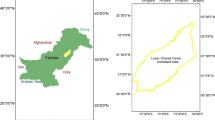Abstract
The Irrigation Optimisation System (IOS), a decision support tool and an extension of the combined hydraulic-hydrological modelling system for canal-command, is applied as a planning tool to the Mahanadi Reservoir Irrigation Scheme, a large irrigation project in Central India. Besides the MIKE 11 and MIKE SHE modelling systems, for the hydraulic and hydrological simulations respectively, it has an optimisation module to govern the canal releases. The results show that presently the canal releases are inefficient and lead to the wastage of a significant amount of water during the monsoon season. It is shown that the application of IOS reduces this wastage and results in higher irrigation intensity and physical productivity of water in the command. The case study also illustrates the capability of IOS as a planning and decision support tool.
Similar content being viewed by others
References
Abbott M.B., Bathurst J.C., Cunge J.A., O'Connell P.E. & Rasmussen J. 1986a. An introduction to the European hydrological system-system hydrologique Europeen (SHE); Part 1: History and philosophy of a physically based distributed modelling system. J. Hydro. 87: 45–59.
Abbott M.B., Bathurst J.C., Cunge J.A., O'Connell P.E. & Rasmussen J. 1986b. An introduction to the European hydrological system-system hydrologique Europeen (SHE); Part 2: Structure of a physically based distributed modelling system. J. Hydro. 87: 61–77.
Agrawal D.K. 1994. Computerised Water Management Planning for Small Irrigation Projects. Annual Report. Agricultural Engineering Department, Indira Gandhi Agricultural University, Raipur, India.
ASCE Task Committee on Irrigation Canal System Hydraulic Modelling. 1993. Unsteady flow modelling of irrigation canals. J. Irrig. and Drain. Engrg. ASCE, 119(4): 615–630.
Biswas A.K. 1994. Considerations for sustainable irrigation development in Asia. Water Resour. Dev. 10(4): 457–474.
Burton M.A. 1994. A simulation of water allocation policies in times of water shortage. Irrig. and Drain. Sys. 8: 61–81.
Chavez-Morales J., Marino M.A. & Holzapfel E.A. 1992. Planning simulation model of irrigation district. J. Irrig. and Drain. Engrg., ASCE, 118(1): 74–87.
Clemmens A.J. & Replogle J.A. 1989. Control of irrigation canal networks. J. Irrig. and Drain. Engrg., ASCE, 115(1): 96–110.
Dudley N.J., Howell D.T. & Musgrave W.F. 1971. Optimal intraseasonal irrigation allocation. Water Resourc. Res. 8(3): 770–789.
Doorenbos J. & Kassam A.H. 1979. Yield Response to water. Irrig. and Drain. Paper No. 33, Food and Agric. Organization of the United Nations, Rome, Italy.
Havnø K., Madsen M.N. & Dørge J. 1995. MIKE 11 - A generalized river modelling package. Computer Models ofWatershed Hydrology, V.P. Singh, ed., Water Resources Publications, Colorado, USA, 733–782.
Katre R.K. 1992. Soils of Chhattisgarh. Advances in Agronomy; Proc., Symp., Raipur, India, 192–196.
Lakshminarayana V. & Rajgopalan S.P. 1977. Optimal cropping pattern for basin in India. J. Irrig. and Drain. Div., ASCE, 103(IR1): 53–70.
Lenton R. 1994. Research and development for sustainable irrigation management. Water Resour. Dev. 10(4): 417–424.
Loof R., Paudyal G.N. & Maguerra H.B. 1991a. Mathematical Modelling of Irrigation Canal Systems: State of the Art. Asian Institute of Technology Monograph No. 2, Bangkok, Thailand.
Loof R., Paudyal G.N. & Maguerra H.B. 1991b. Simulation-based management model for irrigation system typical of South and Southeast Asia: the Phitsanulok experience. International Commission on Irrigation and Drainage Rights; Proc., Afro-Asian Regional Conference, Bangkok, Thailand, 360–371.
Loof R., Das B. & Paudyal G.N. 1994. Improved operation of large irrigation canal systems in Southeast Asia. Water Resour. Dev. 10(4): 393–416.
Malaterre P.O. 1995. Regulation of irrigation canals. Irrig. and Drain. Sys. 9(4): 297–327.
Mazumdar S.K. 1983. Irrigation Engineering. Tata McGraw-Hill Publishing Company Limited, New Delhi, India.
Onta P.R., Das Gupta A. & Paudyal G.N. 1991. Integrated irrigation development planning by multiobjective optimisation. Water Resour. Dev. 7(3): 185–193.
Onta P.R., Loof R. & Banskota M. 1995. Performance based irrigation planning under water shortage. Irrig. and Drain. Sys. 9(2): 143–162.
Paudyal G.N. & Das Gupta A. 1990. Irrigation planning by multilevel optimisation. J. Irrig. and Drain. Engrg., ASCE, 116(2): 273–291.
Refsgaard J.C. & Storm B. 1995. MIKE SHE. Computer Models of Watershed Hydrology, V.P. Singh, ed., Water Resources Publications, Colorado, USA, 809–846.
Small L.E. & Rimal A. 1996. Effects of alternative water distribution rules on irrigation system performance: a simulation analysis. Irrig. and Drain. Sys. 10(1): 25–45.
Singh R., Refsgaard J.C., Yde L., Jogensen G.H. & Thorsen M. 1997. Hydraulic-hydrological simulations of canal-command for irrigation water management. Irrig. and Drain. Sys. 11: 185–213.
Srivastava D.K. & Patel I.A. 1992. Optimisation-simulation models for the design of an irrigation project. Water Resour. Mgmt. 6(4): 315–338.
Stegman E.C. 1983. Irrigation scheduling: applied timing criteria. Advances in Irrigation, Vol. 2, D. Hillel, ed., Academic Press Inc., New York, USA, 1–30.
Steiner R.A. & Keller A.A. 1992. Irrigation land management model. J. Irrig. and Drain. Engrg., ASCE, 118(6): 928–942.
Tomicic B. 1989. A general optimisation module for real-time control of surface water resources, M. Sc. thesis, The International Institute for Hydraulic and Environmental Engineering, Delft, The Netherlands.
Wade R. 1983. Managing a drought with canal irrigation: a case study. Institute of Development Studies, Sussex, UK.
Yaron D. & Harpinist B. 1980. A model for optimal irrigation scheduling with saline water. Water Resour. Res. 16(2): 257–262.
Yaron D., Dinar A. & Meyers S. 1987. Irrigation scheduling - theoretical approach and application problems. Water Resour. Mgmt. 1(1):17–31.
Yde L. 1995. Optimal control of irrigation systems - development of an informatics system. Res. Report No. 8064, Danish Hydraulic Institute, Hørsholm, Denmark.
Author information
Authors and Affiliations
Rights and permissions
About this article
Cite this article
Singh, R., Refsgaard, J. & Yde, L. Application of Irrigation Optimisation System (IOS) to a Major Irrigation Project in India. Irrigation and Drainage Systems 13, 229–248 (1999). https://doi.org/10.1023/A:1006285819990
Issue Date:
DOI: https://doi.org/10.1023/A:1006285819990




